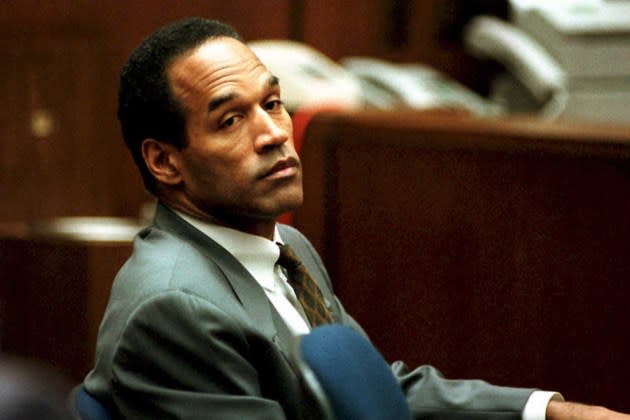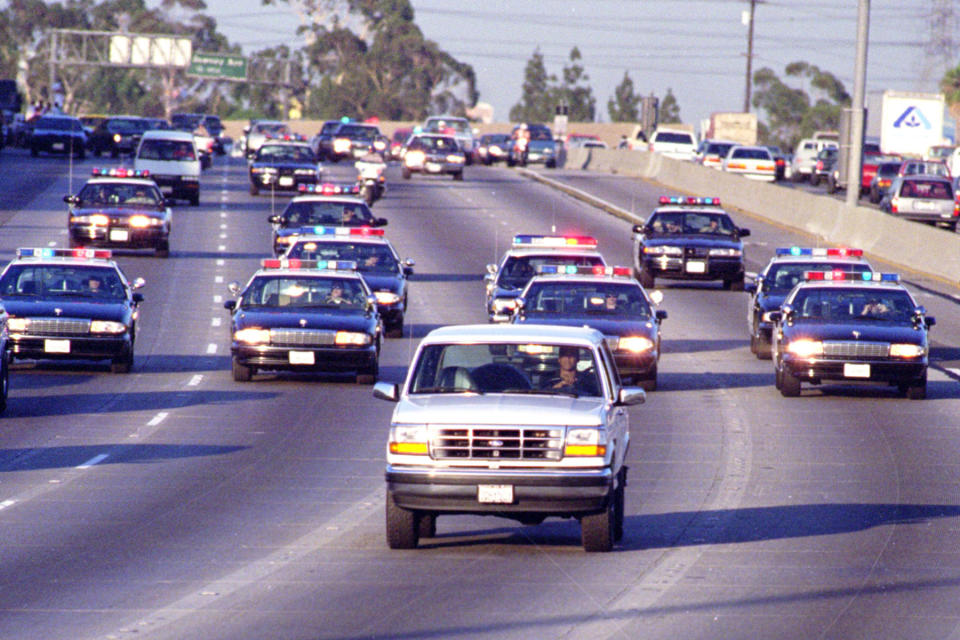How the O.J. Simpson Car Chase and Trial Changed Media Forever
- Oops!Something went wrong.Please try again later.
- Oops!Something went wrong.Please try again later.
- Oops!Something went wrong.Please try again later.
- Oops!Something went wrong.Please try again later.

The slow-speed car chase never really ended.
It began on June 17, 1994, and it happened, appropriately, in prime time for many viewers. A warrant was out for O.J. Simpson’s arrest for the murder of his ex-wife Nicole Brown Simpson and her friend Ron Goldman. And when police caught up with Simpson on a Southern California freeway, a TV news helicopter was hovering overhead.
More from Rolling Stone
'SNL' Weekend Update Addresses O.J.'s Death, Trashes Trump's Abortion Comments
O.J. Simpson Executor Says Ron Goldman's Family Will Get 'Zero, Nothing' From Estate
How the O.J. Simpson Trial Accidentally Inspired a Reality TV Empire
“OK, I’m going to have to interrupt this caller,” CNN’s Larry King said during his show. “I understand we’re going to go to a live picture in Los Angeles… Police believe that O.J. Simpson is in that car.”
“And then,” King recalled later, “for the rest of the night, the next two and a half hours, I anchored the world’s most unusual car chase.”
The broadcast networks also carried the unfolding situation live, and it reached upwards of 95 million viewers. By the end of the evening, the former football star was under arrest, becoming, as King put it, “the most famous person ever charged with murder in the United States.”

Simpson’s death this week rekindled memories of that pursuit by police; his arrest on murder charges; and the subsequent trial that captivated and divided the country. The O.J. case foreshadowed an era of information saturation, when the news is always on, often sensationalized, and everything and everyone is content.
“First the murders, then the actual car chase (especially coming, as it did, during one of the prime time games of the NBA playoff games) and then the trial was a real turning point for American media,” former CNN president Jeff Zucker tells me.
Zucker (who was my boss at CNN) was the executive producer of the Today show in the mid-’90s, and recognized that the American people had an insatiable appetite for coverage of the trial.
“This was more than just another daytime soap opera,” Zucker says. “There were very serious questions of race and crime and status in society at play here. And this was all happening at a time, before streaming services and social media, when cable news was coming into existence, and broadcast news magazines were expanding, and network news was still at the height of the American consciousness.”
No one who covered the 1995 trial would have called it an innocent time; but in retrospect, in some ways, it was. It unfolded in the final decade before broadband internet, social networks, and smartphones. A relatively small number of networks and newspaper columnists dominated the coverage. Stars were made, TV fortunes were won and lost, and viewer expectations were rewritten. “Infotainment” was the new normal.
An untold number of almost forgettable trials and scandals would receive the “O.J. treatment” in the years to come. The proverbial car chases continue to this day across social media.
But the Simpson case actually merited the attention. “No other single news event in our history could match the sheer scope and intensity of coverage given to the O. J. Simpson murder case,” The Spectacle author Paul Thaler wrote. “But the media did not just report the Simpson case, they were instrumental in creating it ― a spectacle of such stupendous proportions that it hijacked American culture.”
This news story was unquestionably huge — even though media critics accused networks of overkill and exploitation. Certain TV producers and shows — like Zucker and Today — saw the case as an opportunity to stand out from the pack. (When I researched the history of morning television for my 2013 book Top of the Morning, I found that NBC’s saturation coverage of the murder trial helped to catapult its morning show, Today, ahead of ABC’s Good Morning America.)
On cable, Larry King Live became the go-to “O.J. show,” helped by the fact that King knew Simpson and some of the other players personally, and by King’s 6 p.m. Pacific time slot, which was ideal for recapping the day’s trial proceedings. King’s “green room,” for upcoming guests, was full of lawyers, expert witnesses, and peripheral players in the case.
In her memoir, Producer: Lessons Shared From 30 Years in Television, King’s longtime executive producer Wendy Walker said, “I once heard Larry say, ‘I do infotainment,’ and I was incredibly turned off. But during the trial, I understood what he meant. The whole idea is that people have to want to watch us. In my opinion, the extraordinary length of this trial marked the beginning of reality television, which offers the audience real information that is entertaining.”
The very 2020s notion of the internet having a “main character” every day was presaged, in 1995, by the celebrification of figures like Johnnie Cochran and Kato Kaelin. The trial “became, I guess you could say, a pop-culture thing,” Kaelin said on the BBC after Simpson’s death. (The network’s anchor noted that Kaelin now hosts a podcast about scandals – a very 2024 way of capitalizing on a 1994 crime.)
A salacious celebrity trial — with overhanging questions about domestic abuse, racial prejudice, and the American judicial system — presented competing realities to the viewing public, years before terms like “echo chambers” and “filter bubbles” became de rigueur. And the media was never the same for it.
Best of Rolling Stone

